|
Irving Block Prison |
|
...Memphis'
Notorious Civil War Prison |
|
|
|
|
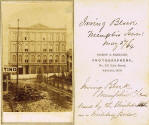 |
|
Irving Block Prison
1864 |
|
During the Civil War, a row of office buildings on
Second Street, opposite the northeast corner of Court
Square had been used as a Confederate hospital.
The original buildings dated from 1860 and were among
the first in the city to have iron fronts.
After the fall of Memphis in 1862, the Union Army turned
them into a Civil War Prison to house Confederate
sympathizers. As a prison, conditions became so
deplorable that even the prison commandant was dismissed
in 1864, but he was re-instated at the request of
General Grant. The prison had become known
as "the filthiest place ever occupied by human beings".
It was so notorious that it was eventually closed by
order of President Lincoln himself.
|
|
|
|
|
|
|
|
The
1864 report to Lincoln stated, "...the prison which is
used for the detention of citizens, prisoners of war on their
way to the North and the United Sates soldiers awaiting trial
and which is located in a large block of stores is represented
as the filthiest place the inspector ever saw occupied by
human beings. The whole management and government of the
prison could not be worse! Discipline and order are
unknown. Food sufficient but badly served. In a
dark wet cellar I found twenty-eight prisoners chained to a
wet floor, where they had been constantly confined, many of
them for several months, one since November 16, 1863, and are
not for a moment released even to relieve the calls of nature.
With a single exception these men have had no trial" |
|
| |
|
Click on small photos to
enlarge them. |
| |
|
|
|
|
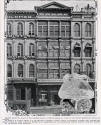 |
 |
 |
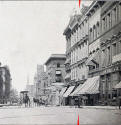 |
 |
|
At one time - a marker |
The
buildings - 1911 |
The buildings in Postcard |
The
buildings - 1907 |
The buildings
- 1937 |
|
| |
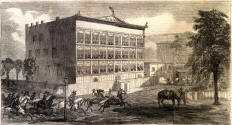 |
|
Forrest's Raid on the
Irving Block |
|
Major
General Nathan Bedford Forrest became obsessed with freeing
prisoners from Irving Block Prison, and it was upper most in his
mind when he made a daring raid on the Union-held city in 1864.
His raid had three objectives: to capture three Union generals
posted in the city; to release Southern prisoners from Irving Block
Prison; and to cause the recall of Union forces from Northern
Mississippi. He struck early in the morning but didn't find
the generals, although one, Major General Washburn made his escape
to Fort Pickering in his night shirt. Union troops were also
able to prevent the attack on Irving Block Prison. Although
the raid failed in two of Forrest's objectives, he was
successful in influencing Union forces to return to Memphis from
northern Mississippi, thus providing the city more protection. |
| |
|
|
|
|
|
Rare 1863 letter from a Irving Block guard, F. W. Shurman of
Rockport, Indiana:
"...I
am on guard duty today, We got paid yesterday and some of the
boys are a little tight today, the most of Co 'K' was tight last
night. I was not..."
(The letter is a very large file. Please be patient as it
opens) |
 |
| |
1863 Letter |
|
|
|
|
The
Loyalty Oath,
was a document signed by persons during and after the Civil War
to pledge loyalty and allegiance to the Union. People who wanted
to do business with the government, Confederate prisoners of war
who wanted parole, Southerners who wanted to be reimbursed for
goods taken by foraging federal troops, and Union sympathizers
in the South who wanted to govern themselves – all took the
oath. Some took it numerous times. In Memphis some of
those who refused to sign the Oath were "detained" at
Irving Block. |
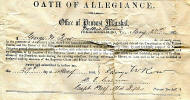 |
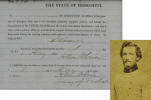 |
| |
Loyalty Oath |
Loyalty Oath |
|
|
|
|
|
|
Reimbursement:
On the
roster of "Civil War Union Prisoner of War Camps", Irving Block is
noted as a Type 3 Prison (Old Building converted to Prison).
Maximum prisoners 582, 1 escape*, 3 deaths. The building was
relatively new, having been constructed in 1860 and was an
early example of the use of cast iron in Memphis. After
President Lincoln ordered Irving Prison shut down, the block of
buildings were re-structured again as downtown offices. After
the war, the heirs of the building submitted a bill to the US
Government for the use of and damages to the building.
> |
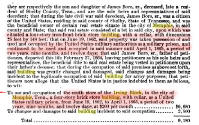 |
|
|
|
|
|
|
|
|
The Irving
Block building was in use as shops and offices until 1937 when it was demolished.
It's not known if the building was demolished because of its past
history or if it was simply another "business as usual, Memphis demolition".
It was demolished to build a Parking Garage, which was also
demolished in 2013. |
|
|
|
|
|
|
|
* |
Escapes: Real or
legend? |
|
| |
|
|
| |
Confirmed : Rev Reuben Burrow, June 20, 1863
> |
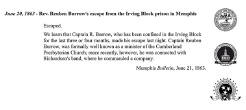 |
| |
|
|
| |
Captain M. A. Miller
> |
|
| |
|
|
| |
Friederich "Fritz" Lilie
> |
 |
| |
|
|
| |
Lieutenant Charles Lewis
> |
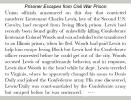 |
| |
|
|
|
|
|
|
|
|
|
|
|
|
|
|
|
Credits |
|
|
|
The
Historic-Memphis website does not intentionally post copyrighted
photos and material without permission or credit.
On
occasion a "non-credited" photo might possibly be posted because we
were unable to find a name to give credit. Because of the nature of
our non-commercial, non-profit, educational website, we strongly
believe that these photos would be considered "Fair Use. We have
certainly made no monetary gain, although those using this website
for historic or Genealogy research have certainly profited. If by
chance,
we have posted your copyrighted photo, please contact us, and we'll
remove it immediately, or we'll add your credit if that's your
choice. In the past, we have found that many photographers
volunteer to have their works included on these pages and we'll
also do that if you contact us with a photo that fits a particular
page. |
|
|
|
The "Historic-Memphis" website would like to acknowledge and thank the
following for their contributions which helped make this website
possible:
Memphis
Public Library, Memphis University Library, Memphis Law Library,
Memphis Commercial Appeal, Memphis Press Scimitar, Shelby County
Register of Deeds, Memphis City Schools, Memphis Business Men's
Club, Memphis Chamber of Commerce, Memphis City Park Commission,
Memphis Film Commision, Carnival Memphis, Memphis Historical
Railroad Page, Memphis Heritage Inc, Beale Street Historic District,
Cobblestone Historic District, Memphis Historic Districts, Vance
Lauderdale Family Archives, Tennessee State Archives, Library of
Congress, Kemmons Wilson Family, Richard S. Brashier, Lee Askew,
George Whitworth, Woody Savage and many individuals whose assistance is
acknowledged on the pages of their contributions. Special
thanks to Memphis Realtor, Joe Spake, for giving us carte blanche
access to his outstanding collection of contemporary Memphis photos.
We do not have high definition copies of the photos on these
pages. If anyone wishes to secure high definition photos,
you'll have to contact the photographer or the collector.
(To avoid any possibility of contributing to SPAM, we do not
maintain a file of email addresses for anyone who contacts us). |
|
|
|
|
|
|
|
historic-memphis.com |
|
|
|
|
|
|
|
|